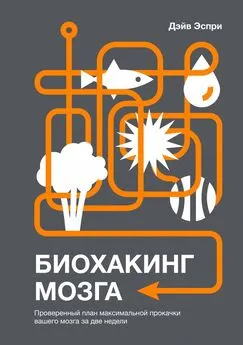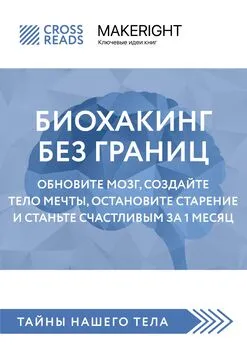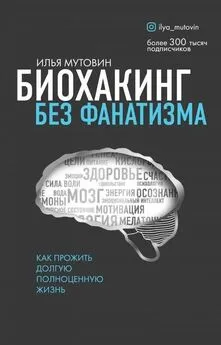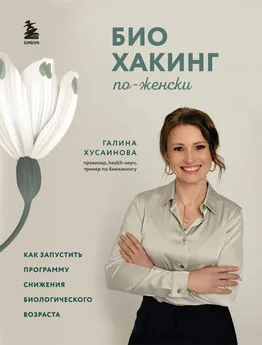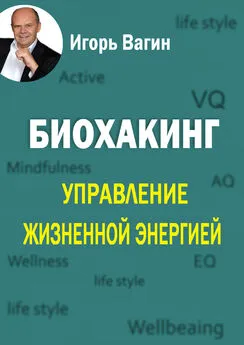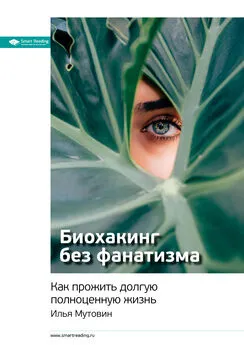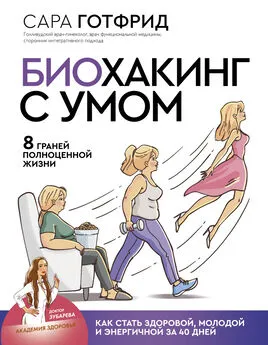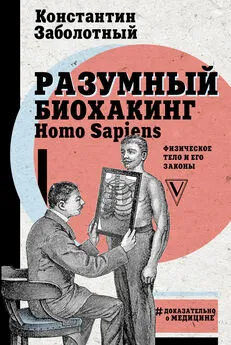Теэму Арина - Биохакинг
- Название:Биохакинг
- Автор:
- Жанр:
- Издательство:неизвестно
- Год:2020
- Город:Москва
- ISBN:978-5-9614-3110-0
- Рейтинг:
- Избранное:Добавить в избранное
-
Отзывы:
-
Ваша оценка:
Теэму Арина - Биохакинг краткое содержание
Авторы – практикующий врач Олли Совиярви, специалист по цифровизации Теэму Арина и эксперт по питанию Яакко Халметоя – доступно рассказывают об одной из самых перспективных и спорных тем нашего века.
Теория, изложенная на базе наработок авторов и анализа результатов исследований, подкреплена множеством простых практических рекомендаций.
Биохакинг - читать онлайн бесплатно ознакомительный отрывок
Интервал:
Закладка:
6
Boyko, E. et al. (2013). Sleep Characteristics, Mental Health, and Diabetes Risk: A prospective study of U.S. military service members in the Millennium Cohort Study. Diabetes Care 36 (10): 3154–3161.
7
Knutson, K. & Ryden, A. & Mander, B. & Van Cauter, E. (2006). Role of Sleep Duration and Quality in the Risk and Severity of Type 2 Diabetes Mellitus. Archives of Internal Medicine 166 (16): 1768–1774.
8
Baglioni, C. et al. (2011). Insomnia as a predictor of depression: A meta-analytic evaluation of longitudinal epidemiological studies. Journal of Affective Disorders 135 (1–3): 10–19.
9
Cohen, S. & Doyle, W. & Alper, C. & Janicki-Deverts, D. & Turner, R. (2009). Sleep Habits and Susceptibility to the Common Cold. Archives of Internal Medicine 169 (1): 62–67.
10
Bounhoure, J. & Galinier, M. & Didier A. & Leophonte P. (2005). Sleep apnea syndromes and cardiovascular disease. Bull Academy of National Medicine 189 (3): 445–459. Review.
11
Härmä, M. (2007). Uni ja terveys. Duodecim 25 (3): 66–68. [date of reference: 22.7.2013]
12
Suomen virallinen tilasto. Työolotutkimus. Helsinki: Tilastokeskus. [date of reference: 22.7.2013]
13
Wagner, U. & Gais, S. & Haider, H. & Verleger, R. & Born, J. (2004). Sleep inspires insight. Nature 427 (6972): 352–355.
14
Cappuccio, F. & D’Elia, L. & Strazzullo, P. & Miller, M. (2010). Sleep duration and all-cause mortality: a systematic review and meta-analysis of prospective studies. Sleep 33 (5): 585–592. Review.
15
Silber, M. et al. (2007). The visual scoring of sleep in adults. Journal of Clinical Sleep Medicine 3 (2): 121–131.
16
Jha, A. & Krompinger, J. & Baime, M. J. (2007). Mindfulness training modifies subsystems of attention. Cognitive, Affective and Behavioral Neuroscience 7: 109–119.
17
Chambers, R. & Lo, B. & Allen, N. (2008). The impact of intensive mindfulness training on attentional control, cognitive style and affect. Cognitive Therapy and Research 32: 303–322.
18
Young, S. (2011). Biologic effects of mindfulness meditation: growing insights into neurobiologic aspects of the prevention of depression. Journal of Psychiatry and Neuroscience 36 (2): 75–77.
19
Walker, M. & Brakefield, T. & Morgan, A. & Hobson, J. & Stickgold, R. (2002). Practice with sleep makes perfect: sleep-dependent motor skill learning. Neuron 35 (1): 205–211.
20
Guzman-Marin, R. et al. (2008). Rapid eye movement sleep deprivation contributes to reduction of neurogenesis in the hippocampal dentate gyrus of the adult rat. Sleep 31 (2): 167–175.
21
Roffwarg, H. & Muzio, J. & Dement, W. (1966). Ontogenetic development of the human sleep-dream cycle. Science 152 (3722): 604–619.
22
Ellenbogen, J. & Payne, J. & Stickgold R. (2006). The role of sleep in declarative memory consolidation: passive, permissive, active or none? Current Opinion Neurobiology 16 (6): 716–722.
23
Wagner, U. & Gais, S. & Haider, H. & Verleger, R. & Born, J. (2004). Sleep inspires insight. Nature 427 (6972): 352–355.
24
Duffy, J. & Czeisler, C. (2009). Effect of Light on Human Circadian Physiology. Sleep Medicine Clinics 4 (2): 165–177.
25
Czeisler, C. et al. (1995). Suppression of melatonin secretion in some blind patients by exposure to bright light. The New England Journal of Medicine 332 (1): 6–11.
26
Utiger, R. (1992). Melatonin – The Hormone of Darkness. New England Journal of Medicine 327 (19): 1377–1379.
27
Wurtman, R. (2000). Age-related decreases in melatonin secretion-clinical consequences. The Journal of Clinical Endocrinology and Metabolism 85 (6): 2135–2136.
28
Falchi, F. & Cinzano, P. & Elvidge, C. & Keith, D. & Haim, A. (2011). Limiting the impact of light pollution on human health, environment and stellar visibility. Journal of Environmental Management 92 (10): 2714–2722.
29
Gellene, D. (2009). Sleeping pill use grows as economy keeps people up at night. Los Angeles Times (March 30, 2009).
30
Chevalier, G. & Sinatra, S. & Oschman, J. & Sokal, K. & Sokal, P. (2012). Earthing: health implications of reconnecting the human body to the Earth’s surface electrons. Journal of Environmental and Public Health 2012: 291541.
31
Zanobetti, A. et al. (2010). Associations of PM10 with sleep and sleepdisordered breathing in adults from seven U.S. urban areas. American Journal of Respiratory and Critical Care Medicine 182 (6): 819–825.
32
Wolverton, B. & Johnson, A. & Bounds, K. (1989). Interior Landscape Plants for Indoor Air Pollution Abatement. NASA/ALCA Final Report , Plants for Clean Air Council, Davidsonville, Maryland.
33
33 Reilly, T. (1990). Human circadian rhythms and exercise. Critical Reviews in Biomedical Engineering 18 (3): 165–180.
34
Youngstedt, S. (2005). Effects of exercise on sleep. Clinical Sports Medicine 24 (2): 355–365. Review.
35
Arendt, J. (2010). Shift work: coping with the biological clock. Occupational Medicine 60 (1): 10–20. Review.
36
Kluger, J. (2013). How the Moon Messes With Your Sleep. A new look at old data gives credence to a long-suspected phenomenon. Time Science and Space (July 25, 2013).
37
Takase, B. (2004). Effect of chronic stress and sleep deprivation on both flow-mediated dilation in the brachial artery and the intracellular magnesium level in humans. Clinical Cardiology 27 (4): 223–227.
38
Abbasi, B. & Kimiagar, M. & Sadeghniiat, K. & Shirazi, M. & Hedayati, M. & Rashidkhani, B. (2012). The effect of magnesium supplementation on primary insomnia in elderly: A double-blind placebo-controlled clinical trial. Journal of Research in Medical Sciences 17 (12): 1161–1169.
39
Drennan, M. & Kripke, D. & Klemfuss, H. & Moore, J. (1991). Potassium affects actigraph-identified sleep. Sleep 14 (4): 357–360.
40
Song, C. & Jung, J. & Oh, J. & Kim, K. (2003). Effects of Theanine on the Release of Brain Alpha Wave in Adult Males. The Korean Journal of Nutrition 36 (9): 918–923.
41
Jang, H. et al. (2012). L-theanine partially counteracts caffeine-induced sleep disturbances in rats. Pharmacology Biochemistry and Behaviour 101 (2): 217–221.
42
Prasad, A. & Mantzoros, C. & Beck, F. & Hess, J. & Brewer, G. (1996). Zinc status and serum testosterone levels in healthy adults. Nutrition 12 (5): 334–338.
43
Barrett-Connor, E. & Dam, T. & Stone, K. & Harrison, S. & Redline, S. & Orwoll, E. (2008). Osteoporotic Fractures in Men Study Group. The association of testosterone levels with overall sleep quality, sleep architecture, and sleep-disordered breathing. The Journal of Clinical Endocrinology Metabolism 93 (7): 2602–2609.
44
Kong, W. et al. (2006). Effects of Taurine on Rat Behaviors in Three Anxiety Models. Pharmacology, Biochemistry, and Behavior 83 (2): 271–276.
45
El Idrissi, A. et al. (2009). Effects of Taurine on Anxiety-Like and Locomotor Behavior of Mice. Advances in Experimental Medicines and Biology 643: 207–215.
46
Aspy, D. & Madden, N. & Delfabbro, P. (2018). Effects of Vitamin B6 (Pyridoxine) and a B Complex Preparation on Dreaming and Sleep. Perceptual and Motor Skills 125 (3): 451–462.
47
Asprey, D. (2012). Bulletproof Your Sleep with Vitamin D. The Bulletproof Executive. [date of reference: 27.9.2013].
48
Johnson, S. (2001). The multifaceted and widespread pathology of magnesium deficiency. Medical Hypotheses 56 (2): 163–170.
49
Deng, X. et al. (2013). Magnesium, vitamin D status and mortality: results from US National Health and Nutrition Examination Survey (NHANES) 2001 to 2006 and NHANES III. BMC Medicine 11: 187.
50
Savage, K. & Firth, J. & Stough, C. & Sarris, J. (2018). GABA-modulating phytomedicines for anxiety: A systematic review of preclinical and clinical evidence. Phytotherapy Research 32 (1): 3–18. Review.
51
Bent, S. & Padula, A. & Moore, D. & Patterson, M. & Mehling, W. (2006). Valerian for sleep: a systematic review and meta-analysis. The American Journal of Medicine 119 (12): 1005–1012.
52
Mao, J. et al. (2014). Long-Term Chamomile Therapy of Generalized Anxiety Disorder: A Study Protocol for a Randomized, Double-Blind, Placebo-Controlled Trial. Journal of clinical trials 4 (5): 188.
53
Suzuki, M. et al. (2009). Pharmacological effects of saw palmetto extract in the lower urinary tract. Acta Pharmacologica Sinica 30 (3): 227–281.
54
Safarinejad, M. (2005). Urtica dioica for treatment of benign prostatic hyperplasia: a prospective, randomized, double-blind, placebo-controlled, crossover study. Journal of Herbal Pharmacotherapy 5 (4): 1–11.
55
Zaghi, S. & Acar, M. & Hultgren, B. & Boggio, P. & Fregni, F. (2010). Noninvasive brain stimulation with low-intensity electrical currents: putative mechanisms of action for direct and alternating current stimulation. Neuroscientist 16 (3): 285–307.
56
Cartwright, R. & Weiss, M. (1975). The effects of electrosleep on insomnia revisited. The Journal of Nervous and Mental Diseases 161 (2): 134–137.
57
Mednick, S. & Nakayama, K. & Stickgold, R. (2003). Sleep-dependent learning: a nap is as good as a night. Nature Neuroscience 6 (7): 697–698.
58
Milner, C. & Cote, K. (2009). Benefits of napping in healthy adults: impact of nap length, time of day, age, and experience with napping. Journal of Sleep Research 18 (2): 272–281.
59
Mednick, S. et al. (2002). The restorative effect of naps on perceptual deterioration. Nature Neuroscience 5 (7): 677–681.
60
Reyner, L. & Horne, J. (1997). Suppression of sleepiness in drivers: combination of caffeine with a short nap. Psychophysiology 34 (6): 721–725.
61
Morris, C. & Aeschbach, D. & Scheer, F. (2011). Circadian system, sleep and endocrinology. Molecular and Cellular Endocrinology 349 (1): 91–104.
Читать дальшеИнтервал:
Закладка:


